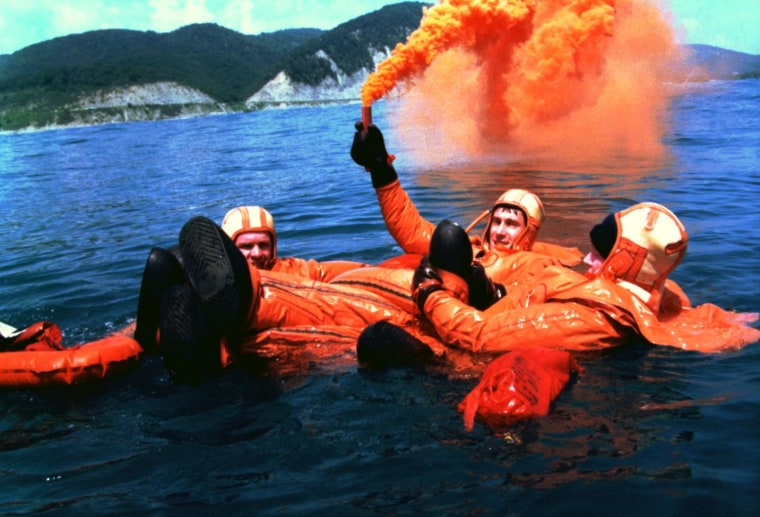As the International Space Station gets ready for a routine change of crew using Russia’s Soyuz spaceships, the Russian government seems to be initiating a subtle gambit to force the United States into a diplomatic trap over the status of Russian-occupied Crimea.
Here’s how it works: Either the United States acknowledges the legitimacy of the recent Russian annexation of that Ukrainian province, or it will be forced by existing agreements to disqualify NASA astronauts from flying aboard Russia’s spaceships, which currently provide the only means to get astronauts to and from the space station.
The challenge appeared this week in an innocent-looking Russian press report, saying that crew survival training for Soyuz spacecraft could be transferred back to the Russian naval base at Sevastopol in Crimea.
Until about 10 years ago, this was the traditional site of splashdown survival training for all cosmonauts. But as space budgets dwindled, that training was transferred to a small lake near Moscow that was deemed adequate for the basics.
This is a prudent contingency preparation for Soyuz flights, which normally come down on dry land on the steppes of Central Asia. In the event of a launch abort, or a time-critical space evacuation, or just a stroke of bad luck, being able to get outside and deploy a raft is critical. One Soyuz actually came down in a lake in 1976, and the result was a near-catastrophe.
Budget squeeze
The Gagarin Cosmonaut Training Center's budget was further squeezed several years ago when it was transferred from Russian Air Force management to the civilian Russian Space Agency, also known as Roscosmos. The center lost almost all of the military transport and training aircraft that it traditionally used, leading to calls for returning the cosmonaut center to military control.
This means that the back-to-Crimea idea — announced by Yuri Lonchakov, a former cosmonaut who now heads the training center — is not based on budget considerations (which are still bad). Nor does it reflect any unique advantages of training on the Black Sea: Cosmonauts have also trained near Sochi, within Russia’s boundaries, and Lonchakov did not propose that site.

Here's the kicker: Shifting the survival training to Russian-occupied Crimea will require foreign cosmonauts to accept travel there without Ukrainian visas, an explicit acquiescence to the new diplomatic status of the province. Refusal to attend survival training is equivalent to failing the training, which by existing training regulations is an automatic disqualification for flight certification. No Crimea trip, no space trip.
International hardball
It’s not just American astronauts who are pawns in this diplomatic hardball. Besides NASA, there are European and Japanese astronauts in training. Also, Russia has just confirmed plans to fly singer Sarah Brightman to the space station late next year, and her training begins in January. She might be required to perform some of that training in Crimea.
Lonchakov hinted that Crimea might be used for more than sea survival training. "We are also planning, if it works out, to hold sea and mountain survival training," he told the Itar-Tass news agency. He has also said a post-flight rehabilitation center for cosmonauts could be reopened near Yevpatoria, a Crimean coastal resort.
Yevpatoriya is also the site of one of the world’s major space tracking facilities, legally transferred to Ukrainian ownership at independence. In the wake of Crimea's annexation, the facility has been seized by the Russian Space Agency. Several space missions with international partners still use the deep-space communications services of the facility, and their continued usage could be seen as tacit acknowledgment the Russian land grab.
NASA officials have not yet responded to inquiries about the Crimea issue, but the big picture is that this could get really ugly. What will NASA do if the cost of the Russian spaceship tickets, already soaring past the $70 million mark, comes to include accepting Russia's possession of Crimea as well?